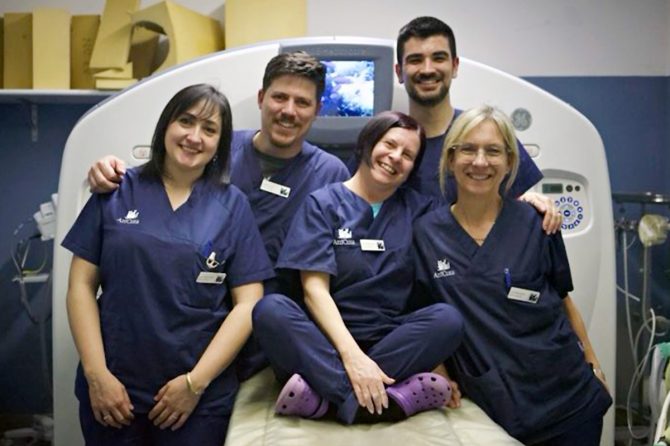CT FEATURES OF CUTANEOUS AND SUBCUTANEOUS CANINE MAST CELL TUMORS
CT features of cutaneous and subcutaneous canine mast cell tumors and utility of conventional and indirect lymphography to detect clinically unknown mast cell tumors and to map the sentinel lymph nodes
Beatrice Gianni, Roberta Franchi, Mirko Mattolini, Barbara Contiero, Gregorio Carozzi, Luigia Nappi, Rocchina Cammarota, Elvanessa Caleri, Federica Rossi, Dott.ssa Luigia Nappi – Centro Oncologico Veterinario
Veterinary Radiology & Ultrasound
First published: 10 February 2024
https://doi.org/10.1111/vru.13338
Leave a replyAbstract
Computed tomography is frequently used to stage canine mast cell tumors (MCTs). The aims of this prospective, observational study were to describe the CT features of MCTs, to evaluate the performance of CT in detecting additional or incidental MCTs, to distinguish between cutaneous (cMCT) or subcutaneous (scMCT) MCTs, and to identify one or multiple sentinel lymph nodes (SLNs) by indirect CT lymphography (ICTL). Seventy-two dogs affected by 111 MCTs were included. The recorded parameters were: shape, size, attenuation (Hounsfield units [HU]), location (cutaneous or subcutaneous), and presence of fat stranding. The SLNs were compared with the regional lymph nodes and supplementary MCTs were registered. Mast cell tumors mostly appeared with well-defined margins (89%), round/oval shape (71%), homogeneous enhancement (90%) with a mean postcontrast density of 62.0 ± 23.4 HU and associated with fat stranding (43%). Cutaneous mast cell tumors were more frequently round (P = .003), whereas scMCTs were oval (P = .011) with a larger mean maximal diameter (2.91 ± 1.57 cm vs 1.46 ± 1.28 cm, P = .002) and more feeding vessels (77% vs 39% P = .044). Compared with histopathology, CT accuracy in differentiating cMCTs and sMCTs was 57%, with an interobserver agreement of 88% (three reviewers). Indirect CT lymphography showed the SLN in 82 of 85 (97%) cases, 32% of them not corresponding to the regional node. CT showed additional or incidental MCTs in 23 of 72 (32%) dogs. In conclusion, the common CT appearance of canine cMCTs and scMCTs is reported with some statistical differences between the two categories. CT is useful in identifying clinically undetected MCTs and SLNs, although it shows low accuracy in distinguishing between cMCT and scMCT.

